COU102A Case Study: Counselling Joel Using Person-Centered Approach
VerifiedAdded on 2023/06/03
|10
|2691
|249
Case Study
AI Summary
This case study explores the application of person-centered therapy to a 36-year-old man named Joel who is experiencing unhappiness and dissatisfaction in his life. The report details Joel's background, including the loss of his mother, his father's anger and alcohol issues, and his current struggles despite professional success. The chosen approach, person-centered therapy, emphasizes empathy, congruence, and unconditional positive regard. The goals of this approach include empowering Joel to change, fostering self-awareness, and encouraging congruence. The study also discusses how person-centered therapy affects the development of self-concept, focusing on self-image, self-worth, and ideal self. Finally, the role of the counsellor is highlighted, emphasizing techniques such as congruence, unconditional positive regard, empathy, and non-directiveness to facilitate Joel's self-discovery and personal growth, creating a therapeutic environment conducive to positive change. Desklib provides a platform for students to access similar case studies and solved assignments.
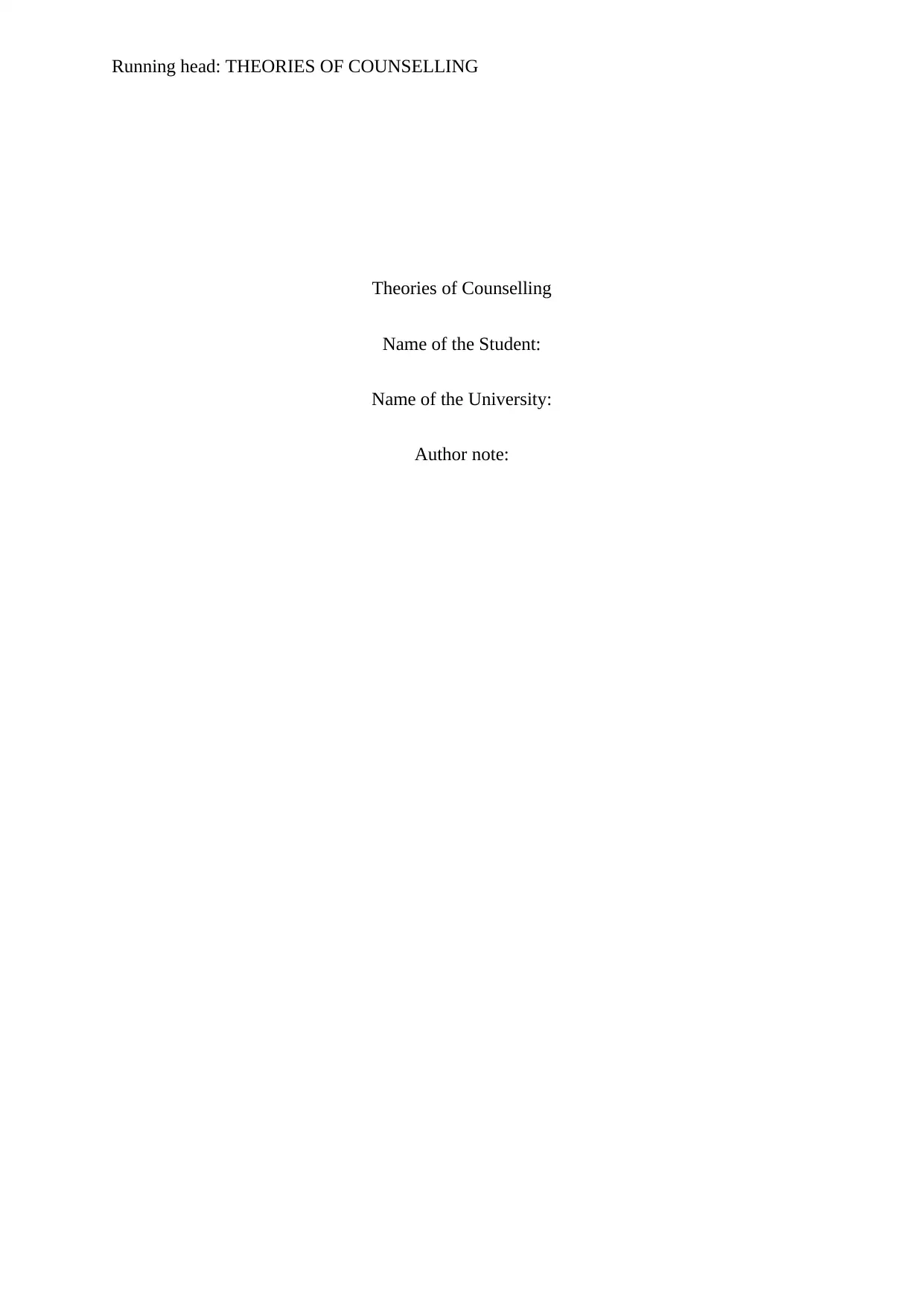
Running head: THEORIES OF COUNSELLING
Theories of Counselling
Name of the Student:
Name of the University:
Author note:
Theories of Counselling
Name of the Student:
Name of the University:
Author note:
Paraphrase This Document
Need a fresh take? Get an instant paraphrase of this document with our AI Paraphraser
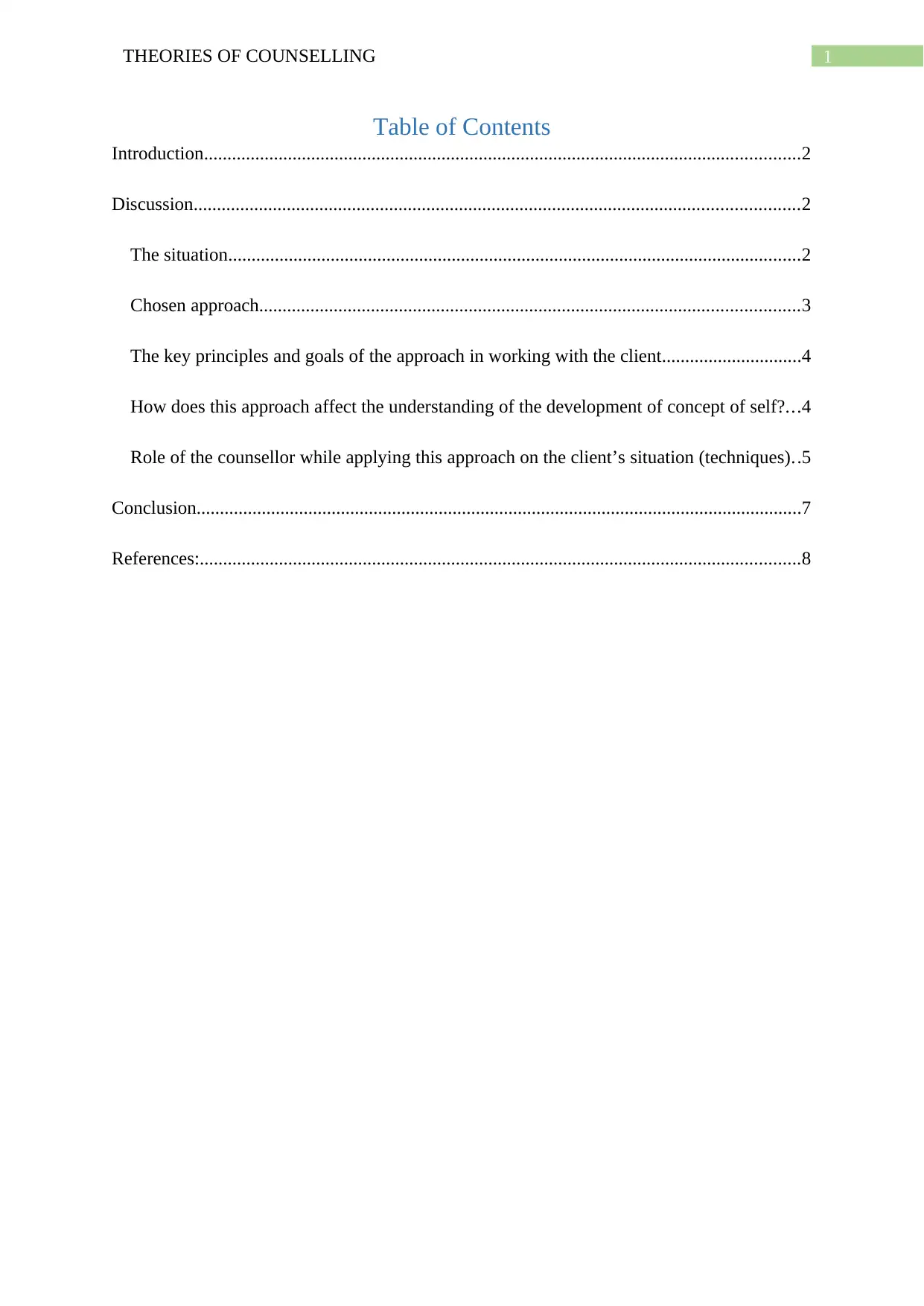
1THEORIES OF COUNSELLING
Table of Contents
Introduction................................................................................................................................2
Discussion..................................................................................................................................2
The situation...........................................................................................................................2
Chosen approach....................................................................................................................3
The key principles and goals of the approach in working with the client..............................4
How does this approach affect the understanding of the development of concept of self?...4
Role of the counsellor while applying this approach on the client’s situation (techniques)..5
Conclusion..................................................................................................................................7
References:.................................................................................................................................8
Table of Contents
Introduction................................................................................................................................2
Discussion..................................................................................................................................2
The situation...........................................................................................................................2
Chosen approach....................................................................................................................3
The key principles and goals of the approach in working with the client..............................4
How does this approach affect the understanding of the development of concept of self?...4
Role of the counsellor while applying this approach on the client’s situation (techniques)..5
Conclusion..................................................................................................................................7
References:.................................................................................................................................8
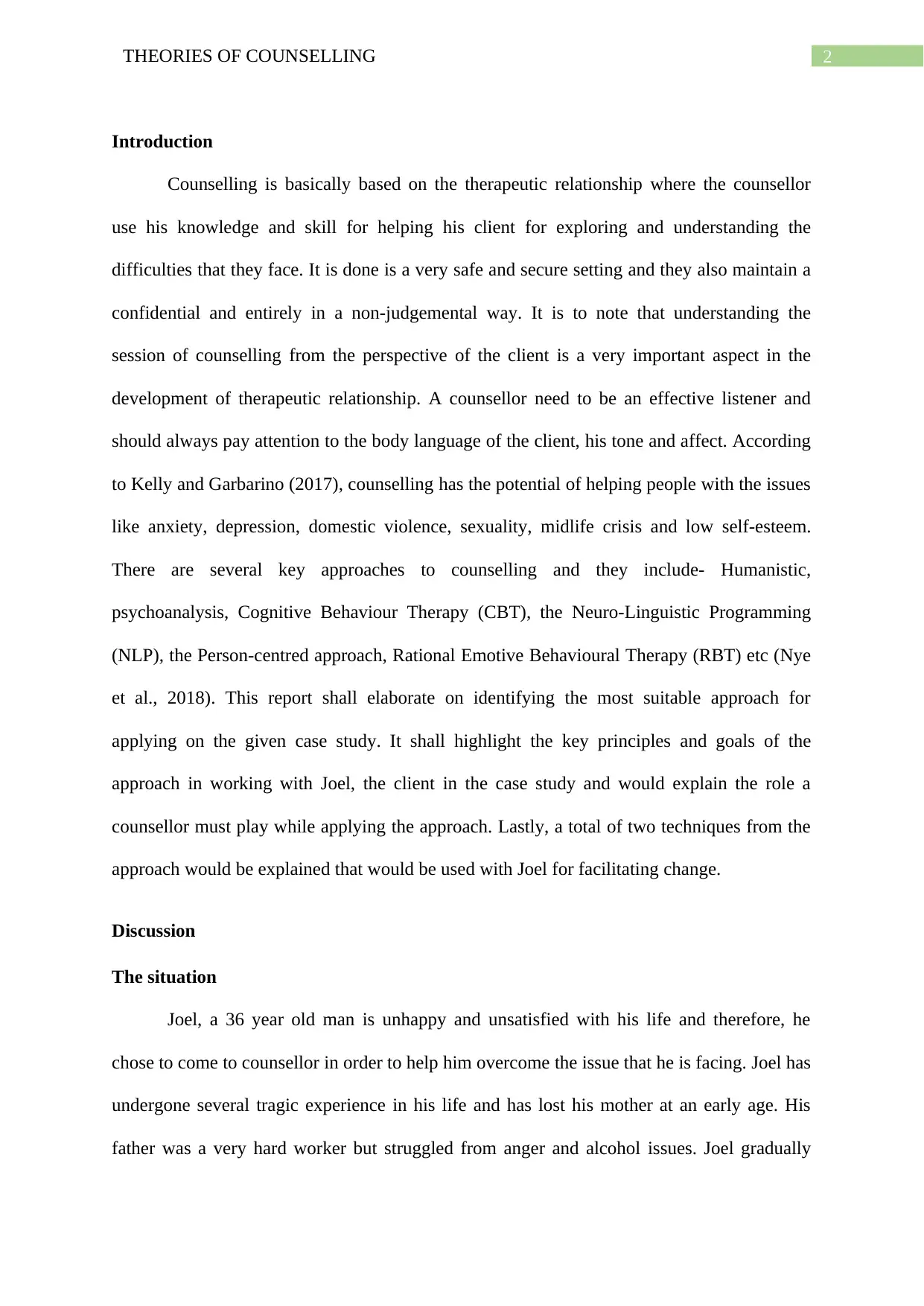
2THEORIES OF COUNSELLING
Introduction
Counselling is basically based on the therapeutic relationship where the counsellor
use his knowledge and skill for helping his client for exploring and understanding the
difficulties that they face. It is done is a very safe and secure setting and they also maintain a
confidential and entirely in a non-judgemental way. It is to note that understanding the
session of counselling from the perspective of the client is a very important aspect in the
development of therapeutic relationship. A counsellor need to be an effective listener and
should always pay attention to the body language of the client, his tone and affect. According
to Kelly and Garbarino (2017), counselling has the potential of helping people with the issues
like anxiety, depression, domestic violence, sexuality, midlife crisis and low self-esteem.
There are several key approaches to counselling and they include- Humanistic,
psychoanalysis, Cognitive Behaviour Therapy (CBT), the Neuro-Linguistic Programming
(NLP), the Person-centred approach, Rational Emotive Behavioural Therapy (RBT) etc (Nye
et al., 2018). This report shall elaborate on identifying the most suitable approach for
applying on the given case study. It shall highlight the key principles and goals of the
approach in working with Joel, the client in the case study and would explain the role a
counsellor must play while applying the approach. Lastly, a total of two techniques from the
approach would be explained that would be used with Joel for facilitating change.
Discussion
The situation
Joel, a 36 year old man is unhappy and unsatisfied with his life and therefore, he
chose to come to counsellor in order to help him overcome the issue that he is facing. Joel has
undergone several tragic experience in his life and has lost his mother at an early age. His
father was a very hard worker but struggled from anger and alcohol issues. Joel gradually
Introduction
Counselling is basically based on the therapeutic relationship where the counsellor
use his knowledge and skill for helping his client for exploring and understanding the
difficulties that they face. It is done is a very safe and secure setting and they also maintain a
confidential and entirely in a non-judgemental way. It is to note that understanding the
session of counselling from the perspective of the client is a very important aspect in the
development of therapeutic relationship. A counsellor need to be an effective listener and
should always pay attention to the body language of the client, his tone and affect. According
to Kelly and Garbarino (2017), counselling has the potential of helping people with the issues
like anxiety, depression, domestic violence, sexuality, midlife crisis and low self-esteem.
There are several key approaches to counselling and they include- Humanistic,
psychoanalysis, Cognitive Behaviour Therapy (CBT), the Neuro-Linguistic Programming
(NLP), the Person-centred approach, Rational Emotive Behavioural Therapy (RBT) etc (Nye
et al., 2018). This report shall elaborate on identifying the most suitable approach for
applying on the given case study. It shall highlight the key principles and goals of the
approach in working with Joel, the client in the case study and would explain the role a
counsellor must play while applying the approach. Lastly, a total of two techniques from the
approach would be explained that would be used with Joel for facilitating change.
Discussion
The situation
Joel, a 36 year old man is unhappy and unsatisfied with his life and therefore, he
chose to come to counsellor in order to help him overcome the issue that he is facing. Joel has
undergone several tragic experience in his life and has lost his mother at an early age. His
father was a very hard worker but struggled from anger and alcohol issues. Joel gradually
⊘ This is a preview!⊘
Do you want full access?
Subscribe today to unlock all pages.

Trusted by 1+ million students worldwide
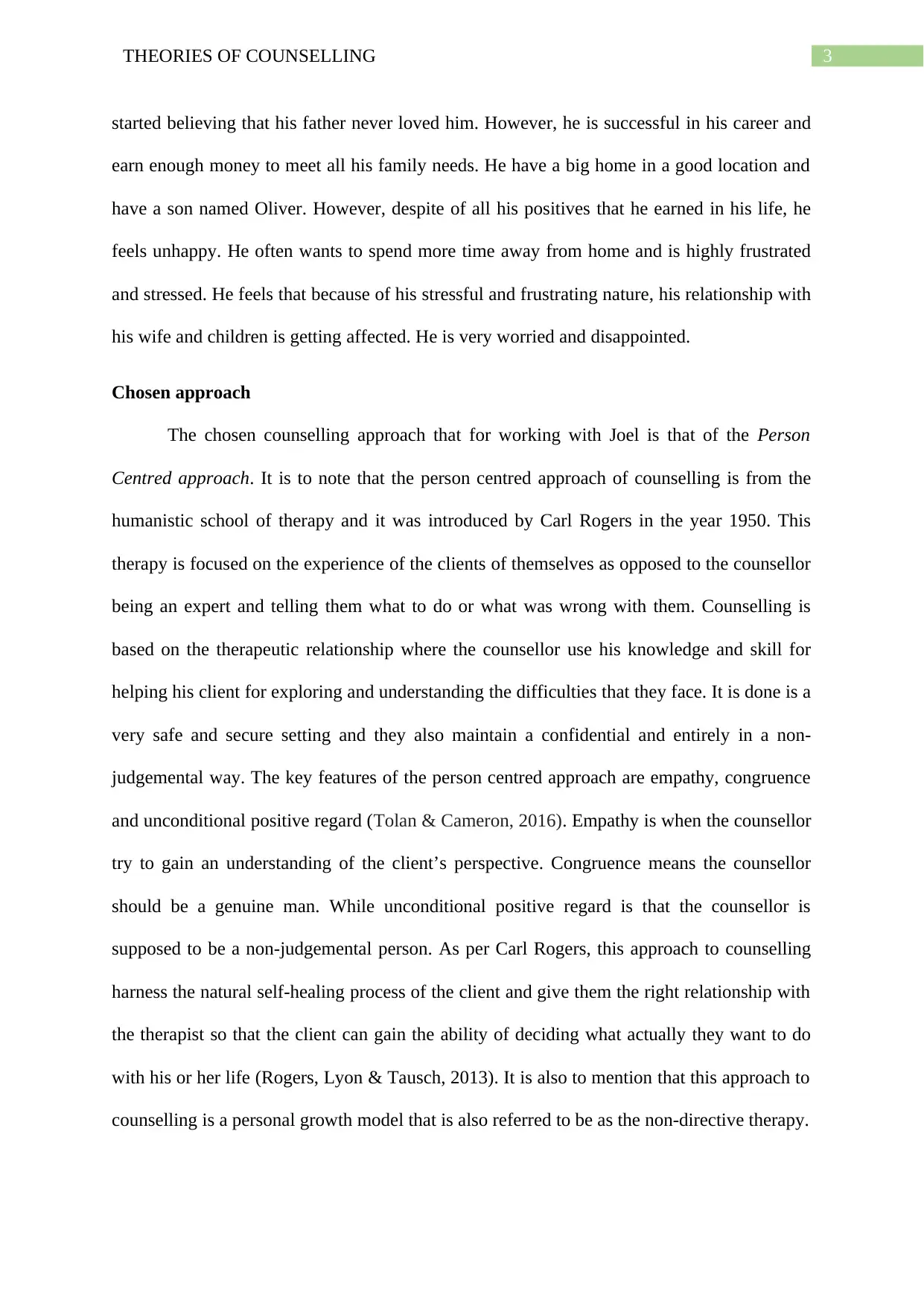
3THEORIES OF COUNSELLING
started believing that his father never loved him. However, he is successful in his career and
earn enough money to meet all his family needs. He have a big home in a good location and
have a son named Oliver. However, despite of all his positives that he earned in his life, he
feels unhappy. He often wants to spend more time away from home and is highly frustrated
and stressed. He feels that because of his stressful and frustrating nature, his relationship with
his wife and children is getting affected. He is very worried and disappointed.
Chosen approach
The chosen counselling approach that for working with Joel is that of the Person
Centred approach. It is to note that the person centred approach of counselling is from the
humanistic school of therapy and it was introduced by Carl Rogers in the year 1950. This
therapy is focused on the experience of the clients of themselves as opposed to the counsellor
being an expert and telling them what to do or what was wrong with them. Counselling is
based on the therapeutic relationship where the counsellor use his knowledge and skill for
helping his client for exploring and understanding the difficulties that they face. It is done is a
very safe and secure setting and they also maintain a confidential and entirely in a non-
judgemental way. The key features of the person centred approach are empathy, congruence
and unconditional positive regard (Tolan & Cameron, 2016). Empathy is when the counsellor
try to gain an understanding of the client’s perspective. Congruence means the counsellor
should be a genuine man. While unconditional positive regard is that the counsellor is
supposed to be a non-judgemental person. As per Carl Rogers, this approach to counselling
harness the natural self-healing process of the client and give them the right relationship with
the therapist so that the client can gain the ability of deciding what actually they want to do
with his or her life (Rogers, Lyon & Tausch, 2013). It is also to mention that this approach to
counselling is a personal growth model that is also referred to be as the non-directive therapy.
started believing that his father never loved him. However, he is successful in his career and
earn enough money to meet all his family needs. He have a big home in a good location and
have a son named Oliver. However, despite of all his positives that he earned in his life, he
feels unhappy. He often wants to spend more time away from home and is highly frustrated
and stressed. He feels that because of his stressful and frustrating nature, his relationship with
his wife and children is getting affected. He is very worried and disappointed.
Chosen approach
The chosen counselling approach that for working with Joel is that of the Person
Centred approach. It is to note that the person centred approach of counselling is from the
humanistic school of therapy and it was introduced by Carl Rogers in the year 1950. This
therapy is focused on the experience of the clients of themselves as opposed to the counsellor
being an expert and telling them what to do or what was wrong with them. Counselling is
based on the therapeutic relationship where the counsellor use his knowledge and skill for
helping his client for exploring and understanding the difficulties that they face. It is done is a
very safe and secure setting and they also maintain a confidential and entirely in a non-
judgemental way. The key features of the person centred approach are empathy, congruence
and unconditional positive regard (Tolan & Cameron, 2016). Empathy is when the counsellor
try to gain an understanding of the client’s perspective. Congruence means the counsellor
should be a genuine man. While unconditional positive regard is that the counsellor is
supposed to be a non-judgemental person. As per Carl Rogers, this approach to counselling
harness the natural self-healing process of the client and give them the right relationship with
the therapist so that the client can gain the ability of deciding what actually they want to do
with his or her life (Rogers, Lyon & Tausch, 2013). It is also to mention that this approach to
counselling is a personal growth model that is also referred to be as the non-directive therapy.
Paraphrase This Document
Need a fresh take? Get an instant paraphrase of this document with our AI Paraphraser
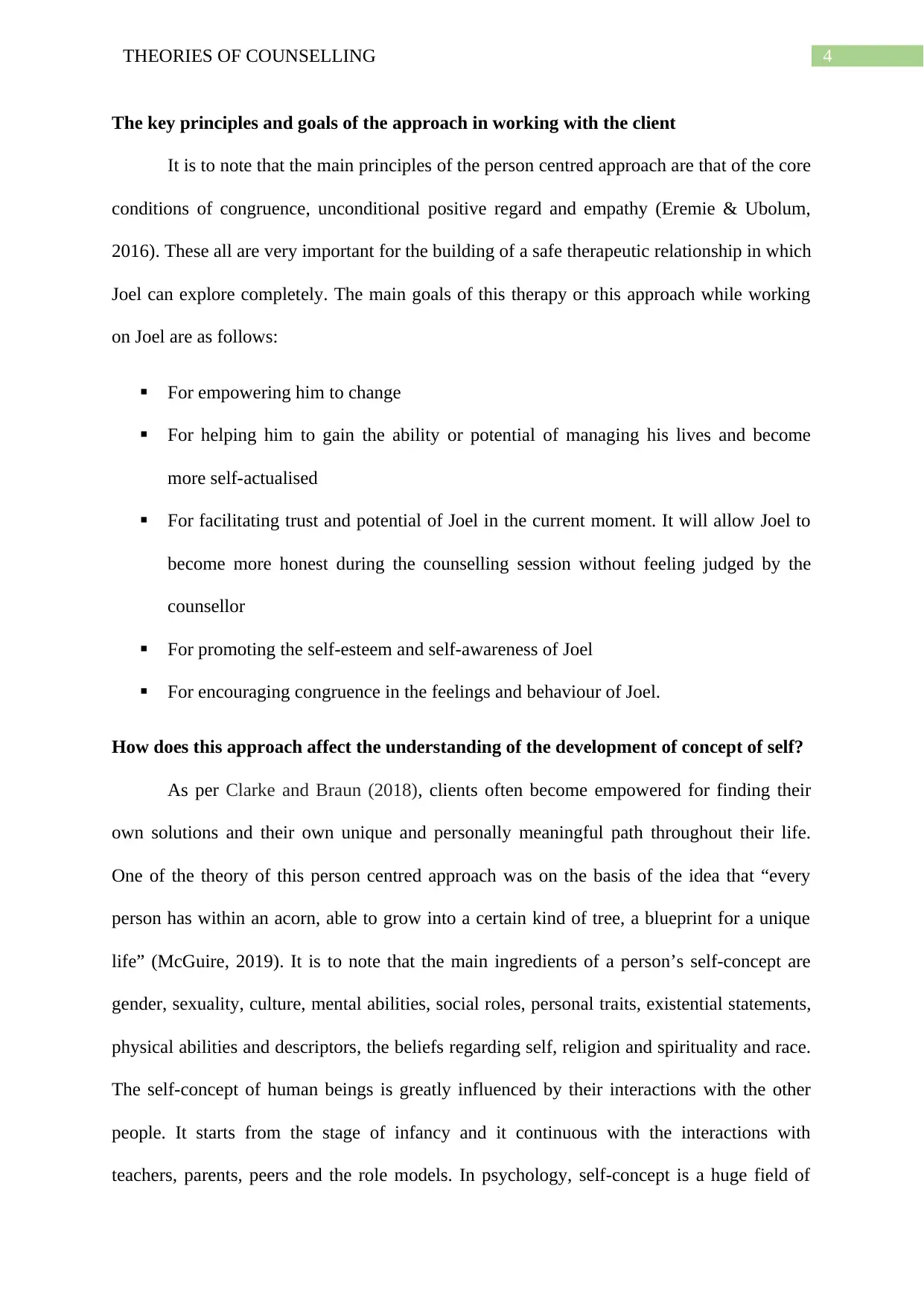
4THEORIES OF COUNSELLING
The key principles and goals of the approach in working with the client
It is to note that the main principles of the person centred approach are that of the core
conditions of congruence, unconditional positive regard and empathy (Eremie & Ubolum,
2016). These all are very important for the building of a safe therapeutic relationship in which
Joel can explore completely. The main goals of this therapy or this approach while working
on Joel are as follows:
For empowering him to change
For helping him to gain the ability or potential of managing his lives and become
more self-actualised
For facilitating trust and potential of Joel in the current moment. It will allow Joel to
become more honest during the counselling session without feeling judged by the
counsellor
For promoting the self-esteem and self-awareness of Joel
For encouraging congruence in the feelings and behaviour of Joel.
How does this approach affect the understanding of the development of concept of self?
As per Clarke and Braun (2018), clients often become empowered for finding their
own solutions and their own unique and personally meaningful path throughout their life.
One of the theory of this person centred approach was on the basis of the idea that “every
person has within an acorn, able to grow into a certain kind of tree, a blueprint for a unique
life” (McGuire, 2019). It is to note that the main ingredients of a person’s self-concept are
gender, sexuality, culture, mental abilities, social roles, personal traits, existential statements,
physical abilities and descriptors, the beliefs regarding self, religion and spirituality and race.
The self-concept of human beings is greatly influenced by their interactions with the other
people. It starts from the stage of infancy and it continuous with the interactions with
teachers, parents, peers and the role models. In psychology, self-concept is a huge field of
The key principles and goals of the approach in working with the client
It is to note that the main principles of the person centred approach are that of the core
conditions of congruence, unconditional positive regard and empathy (Eremie & Ubolum,
2016). These all are very important for the building of a safe therapeutic relationship in which
Joel can explore completely. The main goals of this therapy or this approach while working
on Joel are as follows:
For empowering him to change
For helping him to gain the ability or potential of managing his lives and become
more self-actualised
For facilitating trust and potential of Joel in the current moment. It will allow Joel to
become more honest during the counselling session without feeling judged by the
counsellor
For promoting the self-esteem and self-awareness of Joel
For encouraging congruence in the feelings and behaviour of Joel.
How does this approach affect the understanding of the development of concept of self?
As per Clarke and Braun (2018), clients often become empowered for finding their
own solutions and their own unique and personally meaningful path throughout their life.
One of the theory of this person centred approach was on the basis of the idea that “every
person has within an acorn, able to grow into a certain kind of tree, a blueprint for a unique
life” (McGuire, 2019). It is to note that the main ingredients of a person’s self-concept are
gender, sexuality, culture, mental abilities, social roles, personal traits, existential statements,
physical abilities and descriptors, the beliefs regarding self, religion and spirituality and race.
The self-concept of human beings is greatly influenced by their interactions with the other
people. It starts from the stage of infancy and it continuous with the interactions with
teachers, parents, peers and the role models. In psychology, self-concept is a huge field of
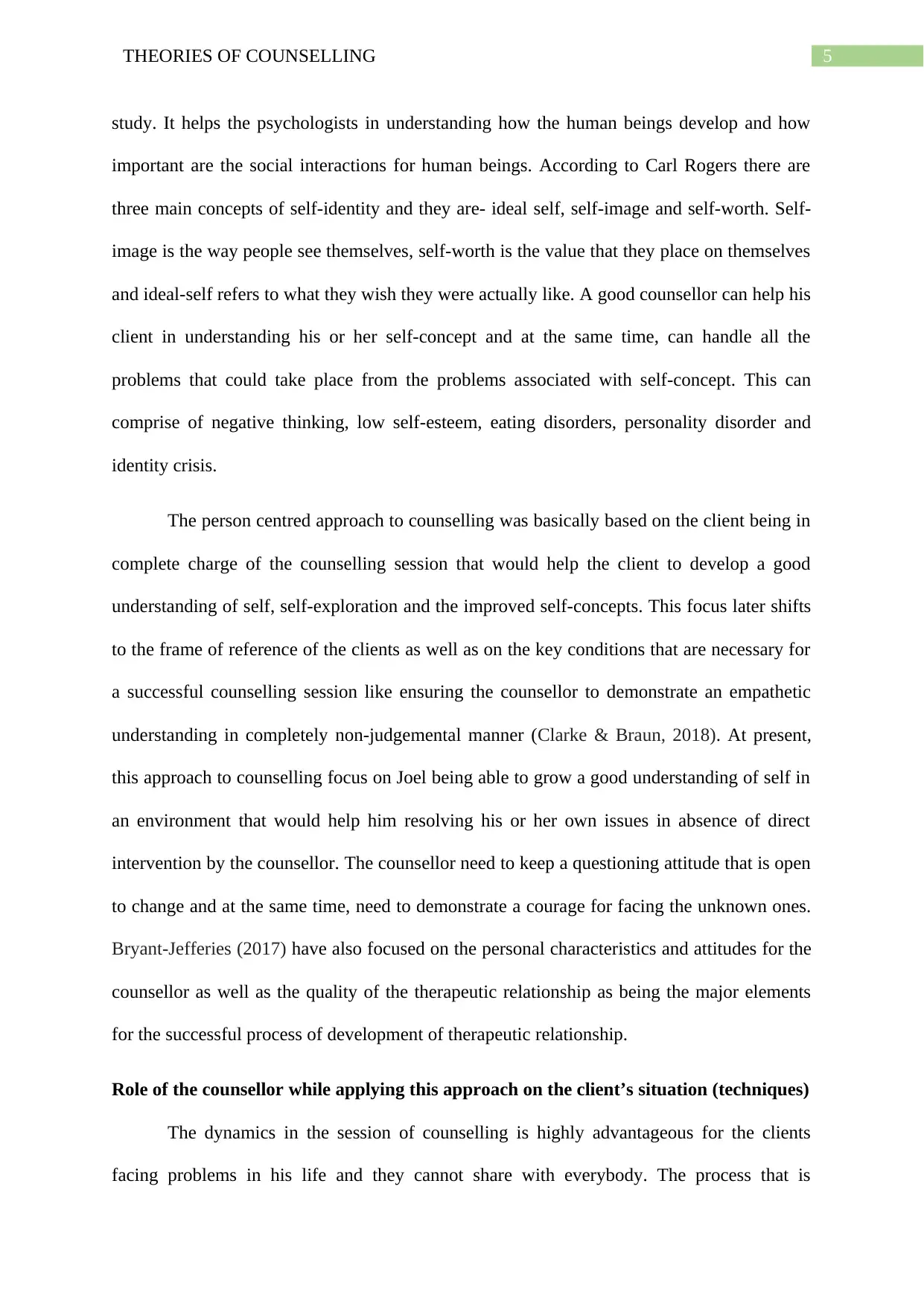
5THEORIES OF COUNSELLING
study. It helps the psychologists in understanding how the human beings develop and how
important are the social interactions for human beings. According to Carl Rogers there are
three main concepts of self-identity and they are- ideal self, self-image and self-worth. Self-
image is the way people see themselves, self-worth is the value that they place on themselves
and ideal-self refers to what they wish they were actually like. A good counsellor can help his
client in understanding his or her self-concept and at the same time, can handle all the
problems that could take place from the problems associated with self-concept. This can
comprise of negative thinking, low self-esteem, eating disorders, personality disorder and
identity crisis.
The person centred approach to counselling was basically based on the client being in
complete charge of the counselling session that would help the client to develop a good
understanding of self, self-exploration and the improved self-concepts. This focus later shifts
to the frame of reference of the clients as well as on the key conditions that are necessary for
a successful counselling session like ensuring the counsellor to demonstrate an empathetic
understanding in completely non-judgemental manner (Clarke & Braun, 2018). At present,
this approach to counselling focus on Joel being able to grow a good understanding of self in
an environment that would help him resolving his or her own issues in absence of direct
intervention by the counsellor. The counsellor need to keep a questioning attitude that is open
to change and at the same time, need to demonstrate a courage for facing the unknown ones.
Bryant-Jefferies (2017) have also focused on the personal characteristics and attitudes for the
counsellor as well as the quality of the therapeutic relationship as being the major elements
for the successful process of development of therapeutic relationship.
Role of the counsellor while applying this approach on the client’s situation (techniques)
The dynamics in the session of counselling is highly advantageous for the clients
facing problems in his life and they cannot share with everybody. The process that is
study. It helps the psychologists in understanding how the human beings develop and how
important are the social interactions for human beings. According to Carl Rogers there are
three main concepts of self-identity and they are- ideal self, self-image and self-worth. Self-
image is the way people see themselves, self-worth is the value that they place on themselves
and ideal-self refers to what they wish they were actually like. A good counsellor can help his
client in understanding his or her self-concept and at the same time, can handle all the
problems that could take place from the problems associated with self-concept. This can
comprise of negative thinking, low self-esteem, eating disorders, personality disorder and
identity crisis.
The person centred approach to counselling was basically based on the client being in
complete charge of the counselling session that would help the client to develop a good
understanding of self, self-exploration and the improved self-concepts. This focus later shifts
to the frame of reference of the clients as well as on the key conditions that are necessary for
a successful counselling session like ensuring the counsellor to demonstrate an empathetic
understanding in completely non-judgemental manner (Clarke & Braun, 2018). At present,
this approach to counselling focus on Joel being able to grow a good understanding of self in
an environment that would help him resolving his or her own issues in absence of direct
intervention by the counsellor. The counsellor need to keep a questioning attitude that is open
to change and at the same time, need to demonstrate a courage for facing the unknown ones.
Bryant-Jefferies (2017) have also focused on the personal characteristics and attitudes for the
counsellor as well as the quality of the therapeutic relationship as being the major elements
for the successful process of development of therapeutic relationship.
Role of the counsellor while applying this approach on the client’s situation (techniques)
The dynamics in the session of counselling is highly advantageous for the clients
facing problems in his life and they cannot share with everybody. The process that is
⊘ This is a preview!⊘
Do you want full access?
Subscribe today to unlock all pages.

Trusted by 1+ million students worldwide
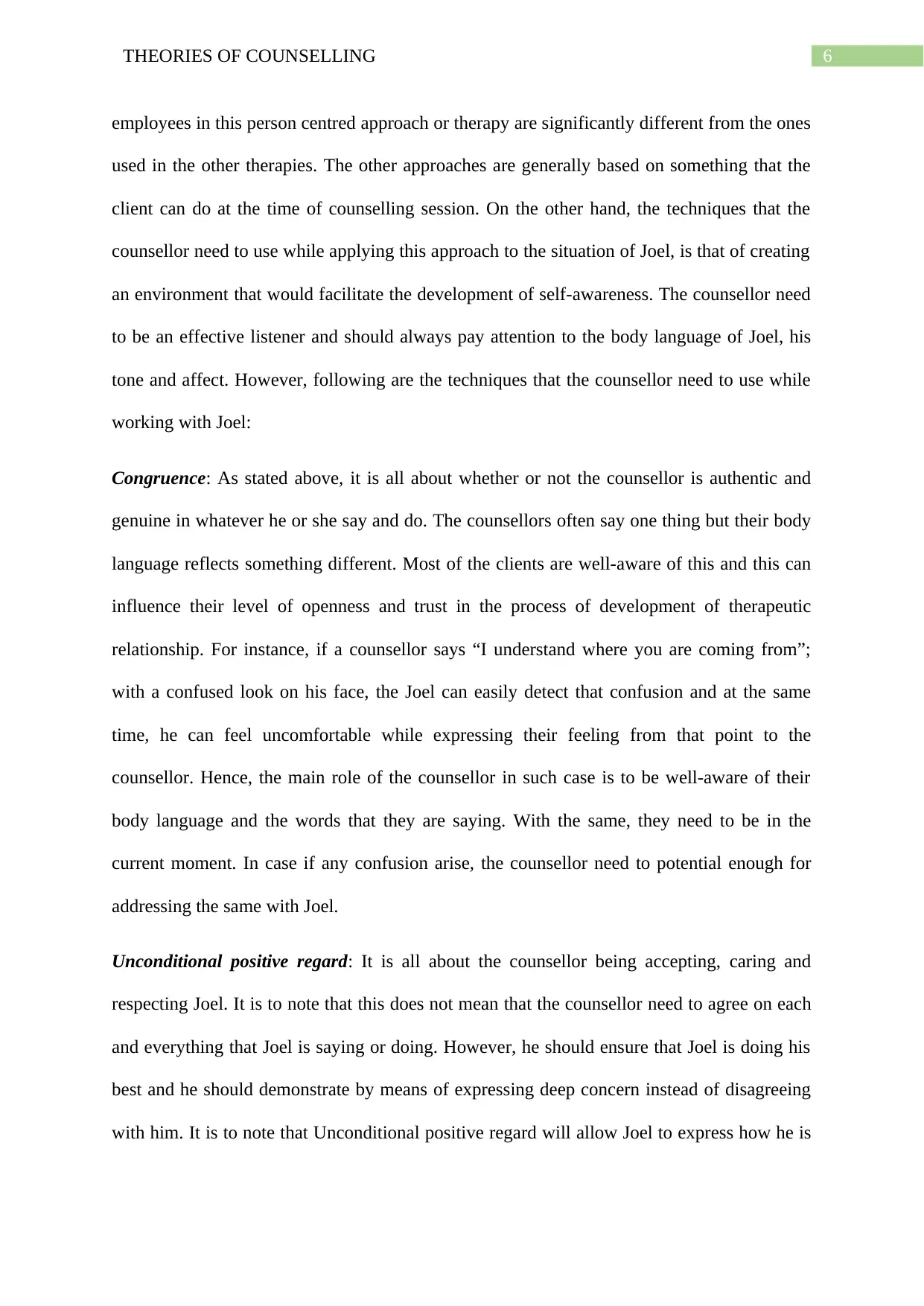
6THEORIES OF COUNSELLING
employees in this person centred approach or therapy are significantly different from the ones
used in the other therapies. The other approaches are generally based on something that the
client can do at the time of counselling session. On the other hand, the techniques that the
counsellor need to use while applying this approach to the situation of Joel, is that of creating
an environment that would facilitate the development of self-awareness. The counsellor need
to be an effective listener and should always pay attention to the body language of Joel, his
tone and affect. However, following are the techniques that the counsellor need to use while
working with Joel:
Congruence: As stated above, it is all about whether or not the counsellor is authentic and
genuine in whatever he or she say and do. The counsellors often say one thing but their body
language reflects something different. Most of the clients are well-aware of this and this can
influence their level of openness and trust in the process of development of therapeutic
relationship. For instance, if a counsellor says “I understand where you are coming from”;
with a confused look on his face, the Joel can easily detect that confusion and at the same
time, he can feel uncomfortable while expressing their feeling from that point to the
counsellor. Hence, the main role of the counsellor in such case is to be well-aware of their
body language and the words that they are saying. With the same, they need to be in the
current moment. In case if any confusion arise, the counsellor need to potential enough for
addressing the same with Joel.
Unconditional positive regard: It is all about the counsellor being accepting, caring and
respecting Joel. It is to note that this does not mean that the counsellor need to agree on each
and everything that Joel is saying or doing. However, he should ensure that Joel is doing his
best and he should demonstrate by means of expressing deep concern instead of disagreeing
with him. It is to note that Unconditional positive regard will allow Joel to express how he is
employees in this person centred approach or therapy are significantly different from the ones
used in the other therapies. The other approaches are generally based on something that the
client can do at the time of counselling session. On the other hand, the techniques that the
counsellor need to use while applying this approach to the situation of Joel, is that of creating
an environment that would facilitate the development of self-awareness. The counsellor need
to be an effective listener and should always pay attention to the body language of Joel, his
tone and affect. However, following are the techniques that the counsellor need to use while
working with Joel:
Congruence: As stated above, it is all about whether or not the counsellor is authentic and
genuine in whatever he or she say and do. The counsellors often say one thing but their body
language reflects something different. Most of the clients are well-aware of this and this can
influence their level of openness and trust in the process of development of therapeutic
relationship. For instance, if a counsellor says “I understand where you are coming from”;
with a confused look on his face, the Joel can easily detect that confusion and at the same
time, he can feel uncomfortable while expressing their feeling from that point to the
counsellor. Hence, the main role of the counsellor in such case is to be well-aware of their
body language and the words that they are saying. With the same, they need to be in the
current moment. In case if any confusion arise, the counsellor need to potential enough for
addressing the same with Joel.
Unconditional positive regard: It is all about the counsellor being accepting, caring and
respecting Joel. It is to note that this does not mean that the counsellor need to agree on each
and everything that Joel is saying or doing. However, he should ensure that Joel is doing his
best and he should demonstrate by means of expressing deep concern instead of disagreeing
with him. It is to note that Unconditional positive regard will allow Joel to express how he is
Paraphrase This Document
Need a fresh take? Get an instant paraphrase of this document with our AI Paraphraser
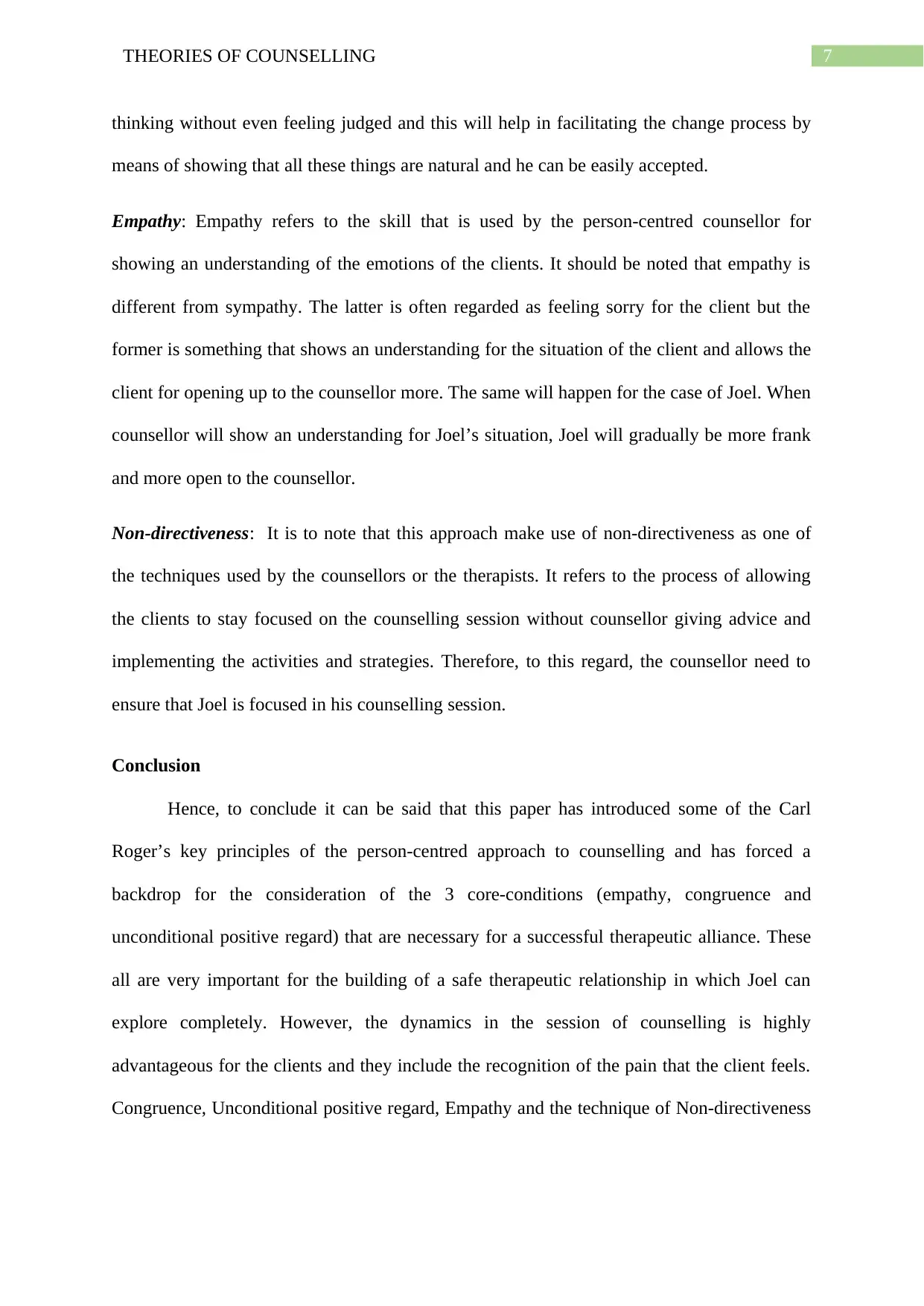
7THEORIES OF COUNSELLING
thinking without even feeling judged and this will help in facilitating the change process by
means of showing that all these things are natural and he can be easily accepted.
Empathy: Empathy refers to the skill that is used by the person-centred counsellor for
showing an understanding of the emotions of the clients. It should be noted that empathy is
different from sympathy. The latter is often regarded as feeling sorry for the client but the
former is something that shows an understanding for the situation of the client and allows the
client for opening up to the counsellor more. The same will happen for the case of Joel. When
counsellor will show an understanding for Joel’s situation, Joel will gradually be more frank
and more open to the counsellor.
Non-directiveness: It is to note that this approach make use of non-directiveness as one of
the techniques used by the counsellors or the therapists. It refers to the process of allowing
the clients to stay focused on the counselling session without counsellor giving advice and
implementing the activities and strategies. Therefore, to this regard, the counsellor need to
ensure that Joel is focused in his counselling session.
Conclusion
Hence, to conclude it can be said that this paper has introduced some of the Carl
Roger’s key principles of the person-centred approach to counselling and has forced a
backdrop for the consideration of the 3 core-conditions (empathy, congruence and
unconditional positive regard) that are necessary for a successful therapeutic alliance. These
all are very important for the building of a safe therapeutic relationship in which Joel can
explore completely. However, the dynamics in the session of counselling is highly
advantageous for the clients and they include the recognition of the pain that the client feels.
Congruence, Unconditional positive regard, Empathy and the technique of Non-directiveness
thinking without even feeling judged and this will help in facilitating the change process by
means of showing that all these things are natural and he can be easily accepted.
Empathy: Empathy refers to the skill that is used by the person-centred counsellor for
showing an understanding of the emotions of the clients. It should be noted that empathy is
different from sympathy. The latter is often regarded as feeling sorry for the client but the
former is something that shows an understanding for the situation of the client and allows the
client for opening up to the counsellor more. The same will happen for the case of Joel. When
counsellor will show an understanding for Joel’s situation, Joel will gradually be more frank
and more open to the counsellor.
Non-directiveness: It is to note that this approach make use of non-directiveness as one of
the techniques used by the counsellors or the therapists. It refers to the process of allowing
the clients to stay focused on the counselling session without counsellor giving advice and
implementing the activities and strategies. Therefore, to this regard, the counsellor need to
ensure that Joel is focused in his counselling session.
Conclusion
Hence, to conclude it can be said that this paper has introduced some of the Carl
Roger’s key principles of the person-centred approach to counselling and has forced a
backdrop for the consideration of the 3 core-conditions (empathy, congruence and
unconditional positive regard) that are necessary for a successful therapeutic alliance. These
all are very important for the building of a safe therapeutic relationship in which Joel can
explore completely. However, the dynamics in the session of counselling is highly
advantageous for the clients and they include the recognition of the pain that the client feels.
Congruence, Unconditional positive regard, Empathy and the technique of Non-directiveness
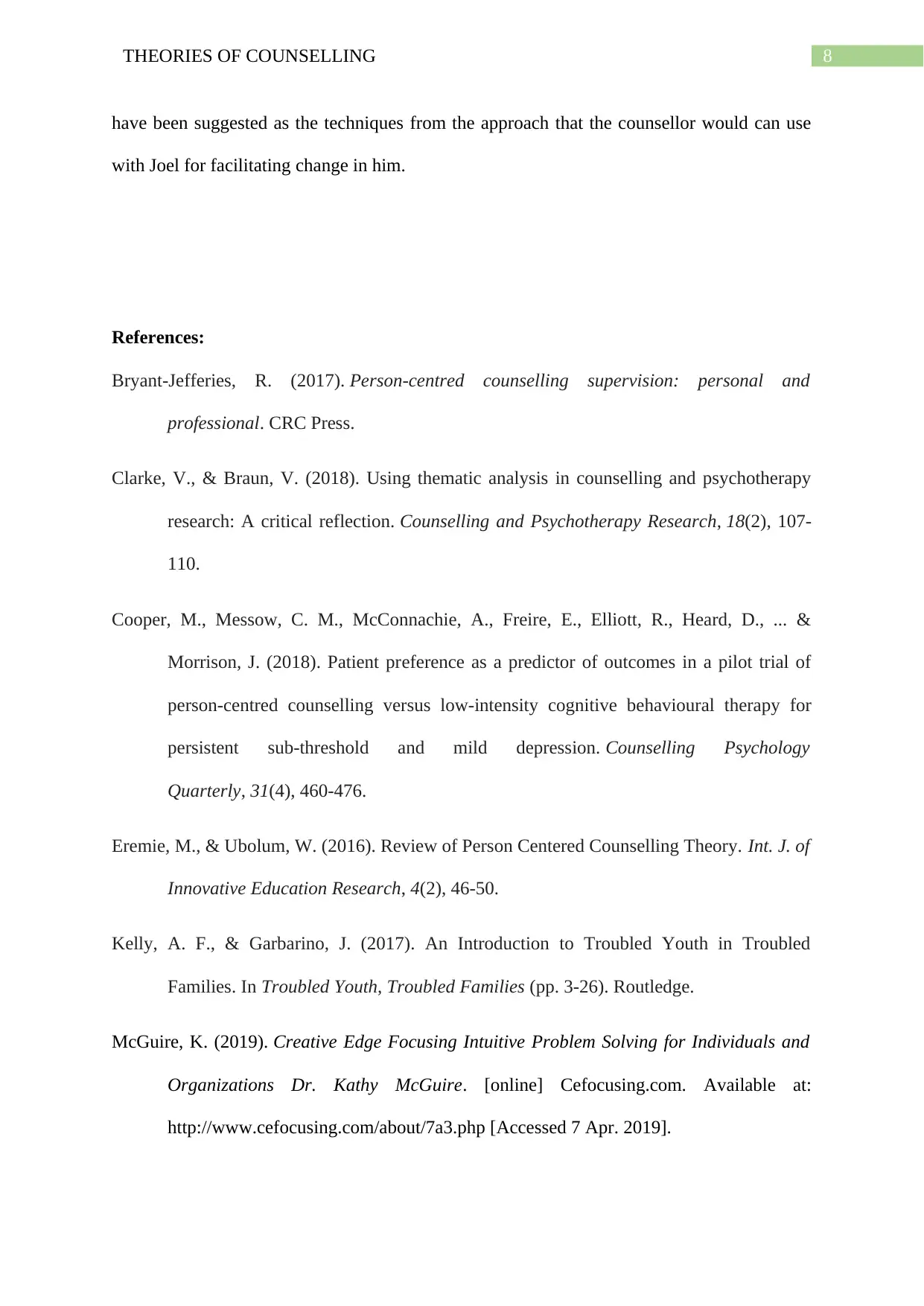
8THEORIES OF COUNSELLING
have been suggested as the techniques from the approach that the counsellor would can use
with Joel for facilitating change in him.
References:
Bryant-Jefferies, R. (2017). Person-centred counselling supervision: personal and
professional. CRC Press.
Clarke, V., & Braun, V. (2018). Using thematic analysis in counselling and psychotherapy
research: A critical reflection. Counselling and Psychotherapy Research, 18(2), 107-
110.
Cooper, M., Messow, C. M., McConnachie, A., Freire, E., Elliott, R., Heard, D., ... &
Morrison, J. (2018). Patient preference as a predictor of outcomes in a pilot trial of
person-centred counselling versus low-intensity cognitive behavioural therapy for
persistent sub-threshold and mild depression. Counselling Psychology
Quarterly, 31(4), 460-476.
Eremie, M., & Ubolum, W. (2016). Review of Person Centered Counselling Theory. Int. J. of
Innovative Education Research, 4(2), 46-50.
Kelly, A. F., & Garbarino, J. (2017). An Introduction to Troubled Youth in Troubled
Families. In Troubled Youth, Troubled Families (pp. 3-26). Routledge.
McGuire, K. (2019). Creative Edge Focusing Intuitive Problem Solving for Individuals and
Organizations Dr. Kathy McGuire. [online] Cefocusing.com. Available at:
http://www.cefocusing.com/about/7a3.php [Accessed 7 Apr. 2019].
have been suggested as the techniques from the approach that the counsellor would can use
with Joel for facilitating change in him.
References:
Bryant-Jefferies, R. (2017). Person-centred counselling supervision: personal and
professional. CRC Press.
Clarke, V., & Braun, V. (2018). Using thematic analysis in counselling and psychotherapy
research: A critical reflection. Counselling and Psychotherapy Research, 18(2), 107-
110.
Cooper, M., Messow, C. M., McConnachie, A., Freire, E., Elliott, R., Heard, D., ... &
Morrison, J. (2018). Patient preference as a predictor of outcomes in a pilot trial of
person-centred counselling versus low-intensity cognitive behavioural therapy for
persistent sub-threshold and mild depression. Counselling Psychology
Quarterly, 31(4), 460-476.
Eremie, M., & Ubolum, W. (2016). Review of Person Centered Counselling Theory. Int. J. of
Innovative Education Research, 4(2), 46-50.
Kelly, A. F., & Garbarino, J. (2017). An Introduction to Troubled Youth in Troubled
Families. In Troubled Youth, Troubled Families (pp. 3-26). Routledge.
McGuire, K. (2019). Creative Edge Focusing Intuitive Problem Solving for Individuals and
Organizations Dr. Kathy McGuire. [online] Cefocusing.com. Available at:
http://www.cefocusing.com/about/7a3.php [Accessed 7 Apr. 2019].
⊘ This is a preview!⊘
Do you want full access?
Subscribe today to unlock all pages.

Trusted by 1+ million students worldwide
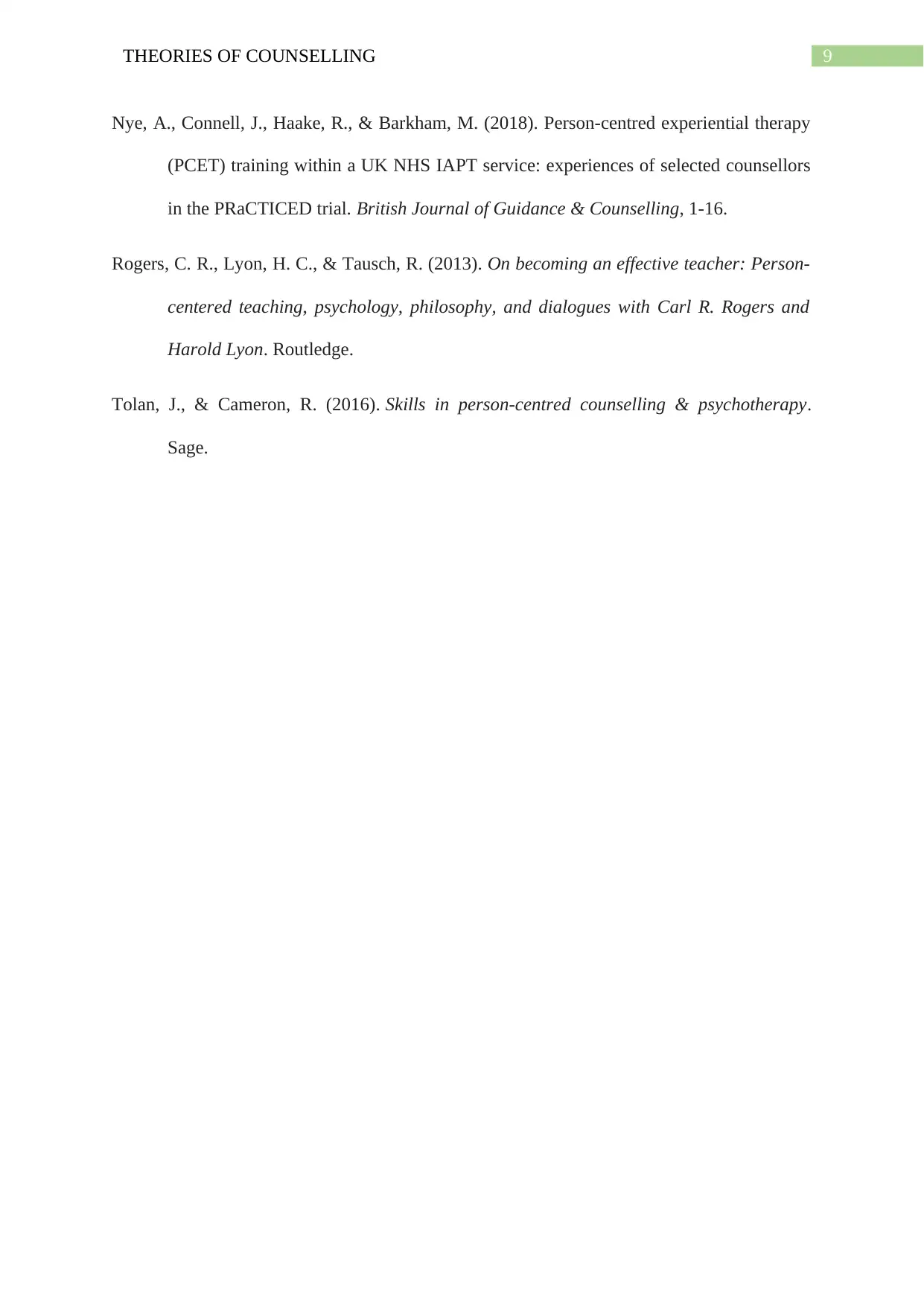
9THEORIES OF COUNSELLING
Nye, A., Connell, J., Haake, R., & Barkham, M. (2018). Person-centred experiential therapy
(PCET) training within a UK NHS IAPT service: experiences of selected counsellors
in the PRaCTICED trial. British Journal of Guidance & Counselling, 1-16.
Rogers, C. R., Lyon, H. C., & Tausch, R. (2013). On becoming an effective teacher: Person-
centered teaching, psychology, philosophy, and dialogues with Carl R. Rogers and
Harold Lyon. Routledge.
Tolan, J., & Cameron, R. (2016). Skills in person-centred counselling & psychotherapy.
Sage.
Nye, A., Connell, J., Haake, R., & Barkham, M. (2018). Person-centred experiential therapy
(PCET) training within a UK NHS IAPT service: experiences of selected counsellors
in the PRaCTICED trial. British Journal of Guidance & Counselling, 1-16.
Rogers, C. R., Lyon, H. C., & Tausch, R. (2013). On becoming an effective teacher: Person-
centered teaching, psychology, philosophy, and dialogues with Carl R. Rogers and
Harold Lyon. Routledge.
Tolan, J., & Cameron, R. (2016). Skills in person-centred counselling & psychotherapy.
Sage.
1 out of 10
Related Documents
Your All-in-One AI-Powered Toolkit for Academic Success.
+13062052269
info@desklib.com
Available 24*7 on WhatsApp / Email
![[object Object]](/_next/static/media/star-bottom.7253800d.svg)
Unlock your academic potential
Copyright © 2020–2025 A2Z Services. All Rights Reserved. Developed and managed by ZUCOL.





